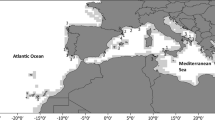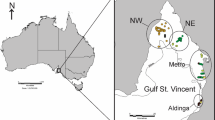Abstract
Anemonefishes’ obligatory mutualism with sea anemones dictates their occurrence in marine habitats. We examined whether the spatial distribution, number, and size of the host anemones Heteractis crispa and Entacmaea quadricolor affected the settlement, habitat usage, and survival of the two-band anemonefish, Amphiprion bicinctus. In a 200 × 50 m study site off the coast of Israel in the Gulf of Eilat, we followed the fish and anemone populations initially in 13 censuses from October 1996 to August 1997 and follow-up censuses from 1998 to 2015. Based on size, anemonefish were categorized as adults, juveniles, or settlers. Settlers tended to cluster together but displayed significantly dispersed distributions in relation to adult individual fish and breeding pairs. Adult and juvenile anemonefish associated more with, and exhibited higher survival in, E. quadricolor. Settlers primarily inhabited H. crispa, with similar survival rates in the two anemone species. H. crispa was less occupied compared to E. quadricolor, but 95 % of the 233 anemones hosted fish during at least one census. From 1997 to 2015, anemone and anemonefish numbers plummeted by 86 % and 74 %, respectively. In 2015, all 27 remaining anemones were occupied, with most E. quadricolor inhabited by adults. The anemones left at the study site, on average, hosted more fish per anemone than those in the original population. This saturated habitat could hinder new anemonefish individuals from settling. These results indicate that if the anemone population does not recover, the anemonefish could face local extinction.






Similar content being viewed by others
References
Allen G (1972) Anemonefishes: their classification and biology. TFH Publications, Neptune City
Ben-Tzvi O, Kiflawi M, Polak O, Abelson A (2009) The effect of adult aggression on habitat selection by settlers of two coral-dwelling damselfishes. PLoS One 4:e5511. doi:10.1371/journal.pone.0005511
Brolund TM, Tychsen A, Nielsen LE, Arvedlund M (2004) An assemblage of the host anemone Heteractis magnifica in the northern Red Sea, and distribution of the resident anemonefish. J Mar Biol Assoc UK 84:671–674. doi:10.1017/S0025315404009737h
Buston PM (2003) Forcible eviction and prevention of recruitment in the clown anemonefish. Behav Ecol 14:576–582. doi:10.1093/beheco/arg036
Buston PM (2004) Does the presence of non-breeders enhance the fitness of breeders? An experimental analysis in the clown anemonefish Amphiprion percula. Behav Ecol Sociobiol 57:23–31. doi:10.1007/s00265-004-0833-2
Cardini U, van Hoytema N, Al-Rshaidat MMD, Schuhmacher H, Wild C, Naumann MS (2015) 37 years later: revisiting a Red Sea long-term monitoring site. Coral Reefs 34:1111. doi:10.1007/s00338-015-1321-z
Chadwick NE, Arvedlund M (2005) Abundance of giant sea anemones and patterns of association with anemonefish in the northern Red Sea. J Mar Biol Assoc UK 85:1287–1292. doi:10.1017/S0025315405012440
Day J (2008) The need and practice of monitoring, evaluating and adapting marine planning and management—lessons from the great barrier reef. Mar Policy 32:823–831. doi:10.1016/j.marpol.2008.03.023
Dirnwöber M, Herler J (2007) Microhabitat specialisation and ecological consequences for coral gobies of the genus Gobiodon in the Gulf of Aqaba, northern Red Sea. Mar Ecol Prog Ser 342:265–275. doi:10.3354/meps342265
Dunn DF (1981) The clownfish sea anemones: Stichodactylidae (Coelenterata: Actiniaria) and other sea anemones symbiotic with pomacentrid fishes. Trans Am Philos Soc 71:3–115. doi:10.2307/1006382
Elliott JK, Mariscal RN (2001) Coexistence of nine anemonefish species: differential host and habitat utilization, size and recruitment. Mar Biol 138:23–36. doi:10.1007/s002270000441
Elliott JK, Elliott JM, Mariscal RN (1995) Host selection, location and association behaviors of anemonefishes in field settlement experiments. Mar Biol 122:377–389. doi:10.1007/BF00350870
Fautin DG (1991) The anemonefish symbiosis: what is known and what is not. Symbiosis 10:23–46
Fautin DG (1992) Anemonefish recruitment: the roles of order and chance. Symbiosis 14:143–160
Fautin DG, Allen GR (1997) Field guide to anemonefishes and their host sea anemones, Revised edn. Western Australian Museum, Perth, Australia
Fishelson L (1964) Observations on the biology and behaviour of Red Sea coral fishes. Bull Sea Fish Res Stn Haifa 37:11–26
Fishelson L (1970) Littoral fauna of the Red Sea: the population of non-scleractinian anthozoans of shallow waters of the Red Sea (Eilat). Mar Biol 6:106–116. doi:10.1007/BF00347239
Fishelson L (1995) Elat (Gulf of Aqaba) littoral: life on the red line of biodegradation. Isr J Zool 41:43–55. doi:10.1080/00212210.1995.10688777
Fishelson L, Popper D, Avidor A (1974) Biosociology and ecology of pomacentrid fishes around the Sinai peninsula (northern Red Sea). J Fish Biol 6:119–133. doi:10.1111/j.1095-8649.1974.tb04532.x
Fricke HW (1974) Eco-ethology of the anemone fish Amphiprion bicinctus (field studies in the Red Sea). Z Tierpsychol 36:429–512
Fricke HW (1979) Mating system, resource defence and sex change in the anemonefish Amphiprion akallopisos. Z Tierpsychol 50:313–326. doi:10.1111/j.1439-0310.1979.tb01034.x
Friedlander AM, Beets J (2008) Temporal trends in reef fish assemblages inside Virgin Islands National Park and around St. John, US Virgin islands, 1988–2006. NOAA Technical Memorandum NOS NCCOS 70. NOAA/National Centers for Coastal Ocean Science, Silver Spring, MD, p. 60
Frisch AJ, Rizzari JR, Munkres KP, Hobbs J-PA (2016) Anemonefish depletion reduces survival, growth, reproduction and fishery productivity of mutualistic anemone–anemonefish colonies. Coral Reefs 35:375–386. doi:10.1007/s00338-016-1401-8
Godwin J, Fautin DG (1992) Defense of host actinians by anemonefishes. Copeia 1992:902–908. doi:10.2307/1446171
Hattori A (1991) Socially controlled growth and size-dependent sex change in the anemonefish Amphiprion frenatus in Okinawa, Japan. Jpn J Ichthyol 38:165–177. doi:10.1007/BF02905541
Hattori A (2002) Small and large anemonefishes can coexist using the same patchy resources on a coral reef, before habitat destruction. J Anim Ecol 71:824–831. doi:10.1046/j.1365-2656.2002.00649.x
Hattori A (2005) High mobility of the protandrous anemonefish Amphiprion frenatus: nonrandom pair formation in limited shelter space. Ichthyol Res 52:57–63. doi:10.1007/s10228-004-0253-3
Hobbs JP, Frisch AJ, Ford BM, Thums M, Saenz-Agudelo P, Furby KA, Berumen ML (2013) Taxonomic, spatial and temporal patterns of bleaching in anemones inhabited by anemonefishes. PLoS One 8:e70966. doi:10.1371/journal.pone.0070966
Hoegh-Guldberg O, Mumby PJ, Hooten AJ, Steneck RS, Greenfield P, Gomez E, Harvell CD, Sale PF, Edwards AJ, Caldeira K, Knowlton N, Eakin CM, Iglesias-Prieto R, Muthiga N, Bradbury RH, Dubi A, Hatziolos ME (2007) Coral reefs under rapid climate change and ocean acidification. Science 318:1737–1742. doi:10.1126/science.1152509
Holbrook SJ, Schmitt RJ (2005) Growth, reproduction and survival of a tropical sea anemone (Actiniaria): benefits of hosting anemonefish. Coral Reefs 24:67–73. doi:10.1007/s00338-004-0432-8
Huebner LK, Dailey B, Titus BM, Khalaf M, Chadwick NE (2012) Host preference and habitat segregation among Red Sea anemonefish: effects of sea anemone traits and fish life stages. Mar Ecol Prog Ser 464:1–15. doi:10.3354/meps09964
Jones AM, Gardner S, Sinclair W (2008) Losing ‘nemo’: bleaching and collection appear to reduce inshore populations of anemonefishes. J Fish Biol 73:753–761. doi:10.1111/j.1095-8649.2008.01969.x
Lönnstedt OM, Frisch AJ (2014) Habitat bleaching disrupts threat responses and persistence in anemonefish. Mar Ecol Prog Ser 517:265–270. doi:10.3354/meps11031
Loya Y (1975) Possible effects of water pollution on the community structure of Red Sea corals. Mar Biol 29:177–185. doi:10.1007/BF00388987
Madduppa HH, Timm J, Kochzius M (2014a) Interspecific, spatial and temporal variability of self-recruitment in anemonefishes. PLoS One 9:e90648. doi:10.1371/journal.pone.0090648
Madduppa HH, von Juterzenka K, Syakir M, Kochzius M (2014b) Socio-economy of marine ornamental fishery and its impact on the population structure of the clown anemonefish Amphiprion ocellaris and its host anemones in Spermonde archipelago, Indonesia. Ocean Coastal Manage 100:41–50. doi:10.1016/j.ocecoaman.2014.07.013
Maroz A, Fishelson L (1997) Juvenile production of Amphiprion bicinctus (Pomacentridae, Teleostei) and rehabilitation of impoverished habitats. Mar Ecol Prog Ser 151:295–297. doi:10.3354/meps151295
McVay MJ (2015) Population dynamics of clownfish sea anemones: patterns of decline, symbiosis with anemonefish, and management for sustainability. Auburn University, Thesis
Mitchell JS, Dill LM (2005) Why is group size correlated with the size of the host sea anemone in the false clown anemonefish? Can J Zool 83:372–376. doi:10.1139/z05-014
Moyer JT (1980) Influence of temperate waters on the behavior of the tropical anemonefish Amphiprion clarkii at Miyake-jima, Japan. Bull Mar Sci 30:261–272
Moyer JT, Sawyers CE (1973) Territorial behavior of the anemonefish Amphiprion xanthurus with notes on the life history. Jpn J Ichthyol 20:85–93
Munday PL, Jones GP, Pratchett MS, Williams AJ (2008) Climate change and the future for coral reef fishes. Fish Fish 9:261–285. doi:10.1111/j.1467-2979.2008.00281.x
Munday PL, Dixson DL, Donelson JM, Jones GP, Pratchett MS, Devitsina GV, Doving KB (2009) Ocean acidification impairs olfactory discrimination and homing ability of a marine fish. Proc Natl Acad Sci U S A 106:1848–1852. doi:10.1073/pnas.0809996106
Pfister RP, Goulet D (1999) Nonintrusive video technique for in situ sizing of coral reef fishes. Copeia 1999:789–793. doi:10.2307/1447616
Pinsky ML, Palumbi SR, Andréfouët S, Purkis SJ (2012) Open and closed seascapes: where does habitat patchiness create populations with high fractions of self-recruitment? Ecol Appl 22:1257-1267. doi:10.1890/11-1240.1
Planes S, Jones GP, Thorrold SR (2009) Larval dispersal connects fish populations in a network of marine protected areas. Proc Natl Acad Sci U S A 106:5693–5697. doi:10.1073/pnas.0808007106
Porat D, Chadwick-Furman NE (2004) Effects of anemonefish on giant sea anemones: expansion behavior, growth, and survival. Hydrobiologia 530:513–520. doi:10.1007/s10750-004-2688-y
R Development Core Team (2014) R: a language and environment for statistical computing. R Foundation for Statistical Computing, Vienna
Richardson DL (1999) Correlates of environmental variables with patterns in the distribution and abundance of two anemonefishes (Pomacentridae: Amphiprion) on an eastern Australian sub-tropical reef system. Environ Biol Fish 55:255–263. doi:10.1023/A:1007596330476
Rinkevich B (2005) What do we know about Eilat (Red Sea) reef degradation? A critical examination of the published literature. J Exp Mar Biol Ecol 327:183–200. doi:10.1016/j.jembe.2005.06.014
Ross RM (1978a) Territorial behavior and ecology of the anemonefish Amphiprion melanopus on Guam. Z Tierpsychol 46:71–83. doi:10.1111/j.1439-0310.1978.tb01439.x
Ross RM (1978b) Reproductive behavior of the anemonefish Amphiprion melanopus on Guam. Copeia 1978:103–107. doi:10.2307/1443829
Sato M, Honda K, Bolisay KO, Nakamura Y, Fortes MD, Nakaoka M (2014) Factors affecting the local abundance of two anemonefishes (Amphiprion frenatus and A. perideraion) around a semi-closed bay in Puerto Galera, the Philippines. Hydrobiologia 733:63–69. doi:10.1007/s10750-013-1758-4
Scott A, Baird AH (2015) Trying to find Nemo: low abundance of sea anemones and anemonefishes on central and southern mid-shelf reefs in the Great Barrier Reef. Mar Biodivers 45:327–331. doi:10.1007/s12526-014-0245-0
Shuman CS, Hodgson G, Ambrose RF (2005) Population impacts of collecting sea anemones and anemonefish for the marine aquarium trade in the Philippines. Coral Reefs 24:564–573. doi:10.1007/s00338-005-0027-z
Srinivasan M, Jones GP, Caley MJ (1999) Experimental evaluation of the roles of habitat selection and interspecific competition in determining patterns of host use by two anemonefishes. Mar Ecol Prog Ser 186:283–292. doi:10.3354/meps186283
Zakai D, Chadwick-Furman NE (2002) Impacts of intensive recreational diving on reef corals at Eilat, northern Red Sea. Biol Conserv 105:179–187. doi:10.1016/S0006-3207(01)00181-1
Acknowledgments
We are indebted to Y. Loya, M. Fine and the faculty and staff of the Interuniversity Institute for Marine Sciences in Eilat for their assistance. We thank R. Pfister, A. Dwileski and A. Mazeroll for field assistance, M. McCauley, K.P. Shirur and anonymous reviewers for their comments, J. Hoeksema for statistical advice, A. Woolsey for ArcGIS assistance, and the Club Hotel Eilat for logistical support. Funding was provided by Sigma Xi, the McRight Fellowship, and the University of Mississippi Graduate School, Graduate Student Council, and Biology Department to JH and the National Science Foundation under Grant No. IOS 0747205 to TLG. Any opinions, findings, and conclusions or recommendations expressed in this material are those of the authors and do not necessarily reflect the views of the National Science Foundation.
Author information
Authors and Affiliations
Corresponding author
Electronic supplementary material
ESM 1
(DOCX 32 kb)
Rights and permissions
About this article
Cite this article
Howell, J., Goulet, T.L. & Goulet, D. Anemonefish musical chairs and the plight of the two-band anemonefish, Amphiprion bicinctus . Environ Biol Fish 99, 873–886 (2016). https://doi.org/10.1007/s10641-016-0530-9
Received:
Accepted:
Published:
Issue Date:
DOI: https://doi.org/10.1007/s10641-016-0530-9




